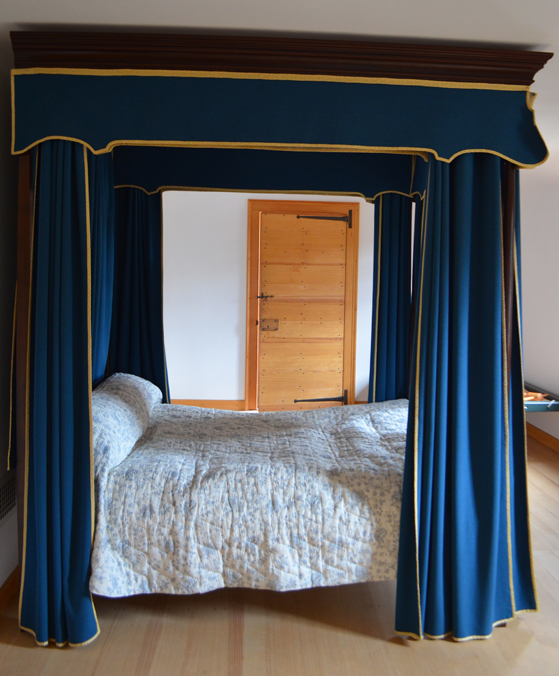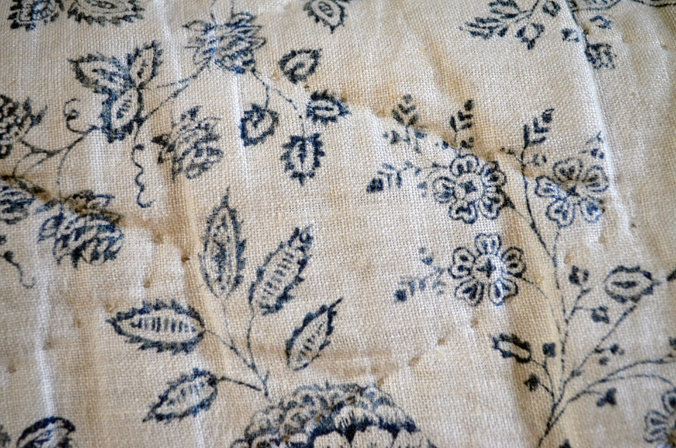 The summer of 2019 was an especially hot one here in Virginia, but we managed to add some cool crispness to the Washington house interior. It came in the form of some new textiles for the “best bed” in the Hall Back Room, in a refreshing blue and white color scheme. As we’ve previously discussed here, blue and white bedroom textiles seemed to be a favorite of Mary Washington’s, throughout her life. Both her will, written in 1788 many years after she had moved away from Ferry Farm and taken up residence in a cottage in downtown Fredericksburg, and the list of her belongings sold at vendu following her death in 1789 contain references to blue and white quilts, coverlets, counterpanes and curtains.
The summer of 2019 was an especially hot one here in Virginia, but we managed to add some cool crispness to the Washington house interior. It came in the form of some new textiles for the “best bed” in the Hall Back Room, in a refreshing blue and white color scheme. As we’ve previously discussed here, blue and white bedroom textiles seemed to be a favorite of Mary Washington’s, throughout her life. Both her will, written in 1788 many years after she had moved away from Ferry Farm and taken up residence in a cottage in downtown Fredericksburg, and the list of her belongings sold at vendu following her death in 1789 contain references to blue and white quilts, coverlets, counterpanes and curtains.

The “Best Bed” in the Hall Back Room of the Washington house at Ferry Farm.
After the “best bed” arrived in 2018, we decked it out in blue wool bedcurtains and a white matelesse summer counterpane. But for winter use, we really wanted to show the bed with the blue and white quilt that is mentioned several times in Mary’s documents, including a reference to it being willed to George Washington himself following Mary’s death. Finding such a quilt turned out to be much more of a challenge than we anticipated, though. The challenge was due to the increasing difficulty in finding ready-made period-appropriate fabric in our modern world. And to understand that difficulty, we need to understand what Mary’s blue and white quilt (probably) looked like.
The description of the quilt as being “blue and white” was not overly specific, but it was actually more descriptive detail than we have for most items in Mary’s household. What could “blue and white” mean? First, it’s important to understand that a “quilt” in the 18th century is almost certainly NOT a patchwork quilt, or an appliqued quilt, both of which came into fashion much later. Instead, an 18th century quilt was usually comprised of a solid piece of decorative fabric, on a layer of filler and a backing fabric, all of which was then quilted, or stitched with decorative patterns. Sometimes the decorative fabric was a solid color, and the intricate stitching patterns were the real decoration, and sometimes the fabric itself had a pattern which was enhanced by the quilting. The ‘blue and white” reference obviously indicates that the quilt was multi-colored, which indicates that the decorative fabric was patterned. So what kind of blue and white patterns were available to Mary Washington in the mid-18th century?
By the mid-1700s, printed cotton textiles had become all the rage in England, and were being heavily imported into the American colonies.[1] The technology for producing printed textiles at that point included resist dying, block printing with mordants and dyes, and copperplate printing (and combinations of all three).[2] Resist dying (in which wax or some kind of dye-resistant substance was applied to sections of fabric meant to stay white, and then the entire fabric was submerged in dye) could produce bold colors and sharp contrast between dyed and undyed sections of fabric, but detail was hard to achieve. Block printing improved the level of detail in patterns, but was still slow and tedious. Copperplate printing allowed for great detail and eventually sped up the process of producing repeated patterns on yardage considerably. Incorporating more than 1 color in the process was still hard to achieve, and so patterns are often monochromatic, with multiple layers of printing being used to create shades of color. Most patterns, no matter the method of printing, involved floral and natural themes, sometimes including birds and other animals, and eventually entire landscape scenes.

Resist

Block printed

Copperplate
So, Mary’s blue and white quilt was most likely similar to one of these styles. Our challenge was to find a modern fabric that accurately depicted one of these processes. Unfortunately, not many modern fabrics are made using the same 18th century technologies, and are more likely to be machine printed using digital images. As a result, these modern patterns usually look too perfect, without the minor imperfections of handmade textiles which actually reveal to us what type of historic process was used to make them. The imperfections are a part of the overall look and feel of the pattern, and make the final product more authentic. It’s a hard thing to achieve these days!
The American textile industry is greatly reduced from what it once was in the early 20th century, and even in Europe, many of the textile factories that once created the patterns that Mary and her contemporaries used in their homes, are gone. Most printed fabrics produced using historic methods these days are produced in small runs and come from small artisan shops – finding both the makers, and enough yardage (and at a price that isn’t prohibitive) of period-correct patterns, can be difficult.

Quilt on the “best bed” in the Washington house.

Close-up view of “best bed” quilt.
After months of searching, we were lucky enough to locate a blue and white printed cotton, reproduced from a mid-18th century French pattern by Chelsea Textiles in New York. The original version was block printed, but also used wax or paste in the resist method. The result was a detailed repeated floral pattern that also had the rounded edges of resist dying. It was perfect for our uses. The fabric was quilted onto filler and backing, and the entire quilt was cut in a T-shape, to fit around the bedposts of the Washington “best bed”, creating a fitted look which was also typical of the time. Visitors to the Washington house can now see Mary’s favorite blues on display in her bedchamber.
Meghan Budinger
Aldrich Director of Curatorial Operations
[1] Eaton, Linda. Printed Textiles, British and American Cottons and Linens, 1700 – 1850. The Monacelli Press, New York. Pg. 65.
[2] Ibid, Pgs. 17 – 41.